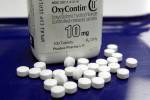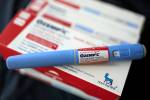Prescription opioid pain medication: five helpful steps for safe use of prescription opioids
(BPT) - If you take prescription opioid pain medication, you are one of the millions of Americans who rely on opioids to support their pain management needs. These opioids are an essential part of your regimen, but they are not without possible side effects – even for the most careful patients.1 Opioid emergencies, such as an accidental overdose, are a growing public health epidemic in the United States. In fact, the CDC states that on average 44 people die in the United States every day because of prescription opioid overdose and that more than 80 percent of those deaths are unintentional.1,2
Even though you may be taking your opioids as directed, it’s essential you understand that an opioid emergency can happen to anyone who takes an opioid whether intentional or unintentional. Here are five helpful steps for the safe use of prescription opioids.
1. Take as directed. When taking your prescription opioid pain medication, it is important you follow the accompanying instructions. Always adhere to your healthcare provider’s instructions and be sure to contact your healthcare provider if you have any questions. You should never guess or assume something when it comes to taking any medication.3
2. Learn as much as you can from your healthcare provider, and talk openly with your friends and family members. If you have questions about your prescription opioid, it’s important to talk openly with your healthcare provider.3 The knowledge you gain will help you to start candid conversations with your friends and family members about the safe use of opioids. There are resources available to help you with these conversations. America Starts Talking is a campaign created to elevate the discussion around the safe use of opioids and to support the conversations between those taking prescription opioids and their healthcare providers, family members and friends. The campaign was created by founding sponsor kaléo, in partnership with multiple leading patient and professional pain organizations. When you visit AmericaStartsTalking.com, you’ll find useful, downloadable discussion tools for the safe use of opioids including: taking the medication as directed; understanding its interactions with other medications and/or alcohol; recognizing signs and symptoms of an opioid emergency, such as an accidental overdose; and having access to naloxone, an opioid antidote, in case of an emergency as encouraged by several professional organizations including the American Medical Association.4 You can learn about starting these conversations and more by visiting AmericaStartsTalking.com.
3. Protect against harmful interactions. While prescription opioids are an important part of pain management, the side effects associated with their use can be serious and, in some cases, life-threatening. Before you start taking your prescription opioid, make sure you tell your healthcare provider about other types of medications you are taking, as well as any existing medical conditions you’re experiencing, to help avoid potentially life-threatening side effects. It’s also important that those who have been prescribed prescription opioids remember to never mix them with alcohol.3
4. Keep it safe. Prescription opioid emergencies, such as an accidental overdose, can occur anywhere an opioid may be present. If you are on a prescription opioid, take safety measures to help ensure that the medication never falls into someone else’s hands.3 Keep your medication locked up if possible, and out of the reach of small children. On average, approximately 3,300 children ages five and under are admitted to the Emergency Department each year due to accidental opioid exposure.5
5. Learn the signs and symptoms of an accidental opioid overdose and incorporate naloxone into your opioid emergency plan. Even with all the available information, the potential for an opioid emergency, such as an accidental overdose, still exists. To protect yourself and your loved ones, learn the signs and symptoms of an opioid emergency and teach them to your family and friends.1 The sooner you or your loved ones can spot an opioid emergency, the sooner action can be taken to help prevent an accident from becoming fatal. Studies show that most opioid emergencies occur in the home and are witnessed by family or friends who may be in the best position to intervene quickly.6
You should also talk to your healthcare provider about having naloxone, an opioid antidote, in the home so that friends, family members or caregivers can rapidly intervene in the event of an opioid emergency. Additionally, it is important to always remember to call 9-1-1 in the event of an opioid emergency.3
If prescription opioids are part of your pain management plan, it’s essential you use them safely and as directed, and are prepared in the event of an emergency.3 Start a conversation with your healthcare provider today to find the answers to your questions – your health and your life may depend on it. For conversation tips and additional resources visit AmericaStartsTalking.com.
Editor’s Note: America Starts Talking is sponsored by kaléo in partnership with The American Academy of Pain Management, The American Chronic Pain Association, The Pain Community and U.S. Pain Foundation.
1 Centers for Disease Control and Prevention. National Vital Statistics System mortality data. (2015) Available at: http://www.cdc.gov/drugoverdose/data/overdose.html. Accessed September 21, 2015.
2 National Center for Health Statistics. NCHS data on drug poisoning deaths. Available at: http://www.cdc.gov/nchs/data/factsheets/factsheet_drug_poisoning.pdf. Accessed September 21, 2015.
3 Substance Abuse and Mental Health Services Administration. SAMHSA Opioid Overdose Prevention Toolkit. HHS Publication No. (SMA) 13-4742. Rockville, MD: Substance Abuse and Mental Health Services Administration, 2013.
4 Harris, P. (2015, June 29). It’s about saving lives: Increasing access to naloxone. Available at: https://www.ama-assn.org/ama/ama-wire/post/its-saving-lives-increasing-access-naloxone. Accessed September 21, 2015.
5 Burghardt LC. Adult Prescription Drug Use and Pediatric Medication Exposures and Poisonings. Pediatrics. 2013;132:18-27.
6 Siegler, A., Tuazon, E., O’Brien, D., & Paone, D. Unintentional opioid overdose deaths in New York City, 2005-2010: a place-based approach to reduce risk. Int J Drug Policy. 2014 May;25(3):569-74.























